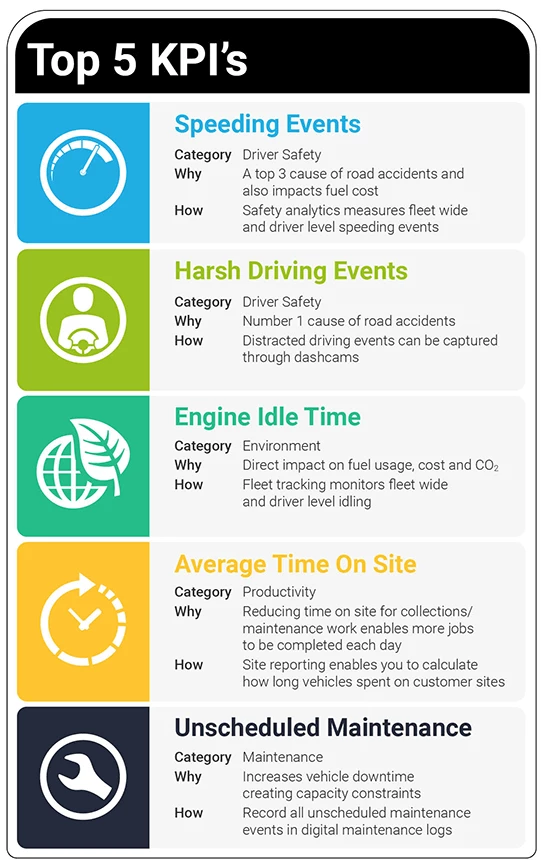According to the most recent Teletrac Navman Telematics Benchmark Report, managing costs is a top business challenge across industries. As payroll, fuel, maintenance, insurance, and other costs continue to rise, keeping an eye on the bottom line is more important than ever. Increasing profits while cutting costs are the top business goals, the report says. However, data shows that fleet management software continues to be underutilized, impacting ROI. Less than one-third of survey respondents said they were using their telematics systems to track cost-related metrics, such as fuel consumption and maintenance.
While most people know vehicle tracking software helps improve operational efficiencies and control costs, it is important to set metrics to measure success.
Here are five areas in which fleet management software can increase ROI:
5 Ways to Increase ROI
Focus on Fuel Savings: Fuel remains the second largest expense for fleet operators, second only to payroll. As fuel prices continue to rise across the nation, fleets feel the pinch. More than half (55%) of fleets have seen a reduction in fuel costs after implementing telematics. Fleet management software helps reduce fuel costs by:
- Improving driver behaviors, such as speeding and excessive idling with audible, in-cab alerts and incentive programs
- Optimizing routing to reduce unnecessary mileage
- Monitoring unauthorized vehicle use outside of working hours
- Monitoring vehicle health and resolving maintenance issues that increase fuel consumption

Keep Compliance on Track: The right fleet tracking system helps you simplify staying compliant with state and federal laws. Remaining compliant is vital to the bottom line and implementing fleet management software can help reduce costs by:
- Digitizing processes and reducing administrative costs
- Preventing regulatory fines and penalties
- Maximizing utilization of available drive time
- Simplifying state fuel tax processes
Use Electronic Maintenance Planning: With maintenance cited as the third-largest expense for organizations, it was surprising that only 32% said they used their fleet tracking software to monitor and plan maintenance-related issues. Telematics can reduce maintenance costs by:
- Helping fleets transition from a reactive maintenance schedule to a pro-active programs based on custom or manufacturer-recommended intervals
- Monitoring engine diagnostics, such as odometer readings, engine hours, engine status, and more to catch issues before they become expensive repair requests
- Improve driver behavior and extend vehicle life by reducing instances of aggressive driving including harsh braking, acceleration and cornering

Create Driver Safety Programs: Safety issues can come with large associated costs, especially when damage or injury is involved. Fleet management software can help businesses implement driver safety programs that work. Increased safety can reduce costs in the following ways:
- Reduced insurance premiums by protecting the business from false claims and by building a better claims history
- Develop a driver safety program designed to reduce incidents that cause vehicles to be off the road, cutting associated rental and maintenance costs
- Keeping your fleet fully operational increases productivity and also helps you meet your commitments to customers

Differentiate Your Business With Technology: All business know that it’s more cost effective to keep a customer than attract new ones. With competition on the rise and customer acquisition costs increasing, retention is a top priority and fleet management software can help your business stand out by:
- Enabling you to better communicate job status or delivery schedules, including real-time updates to customers via text or email
- Providing invoicing transparency showing accurate time on site and delivery time information
- Demonstrating your commitment to customer service, driver safety and environmental impact by investing in the latest technology

Establish a Return on Invest Plan
Like any investment, the key to seeing strong ROI is to have a plan. Ensure you’re tracking the things most important to your business and that you’ve set proper objectives.
The first step is to set tangible, measurable Key Performance Indicators (KPIs). Fleet tracking software, like TN360, offers customizable reporting and analytics tools to help fleet managers and business owners track, analyze and understand essential data. Below are the 5 top fleet management KPI's and why they are important to measure.

The Bottom Line
Generating strong ROI from your investment in fleet management software can be found in almost-endless ways and it is important that you understand the use cases in your business and set KPI measurements against them. Leading fleet management software can automate data capture and help you make sure that you have the information that you need to drive the change you want within your business.
